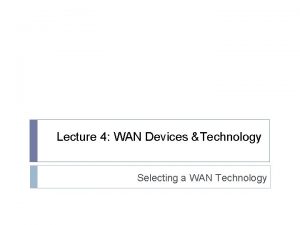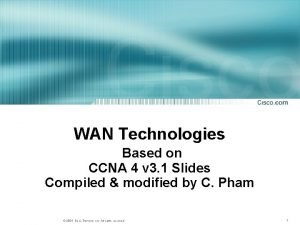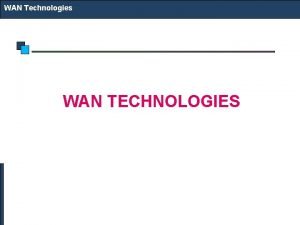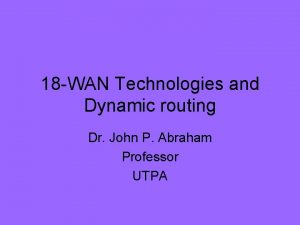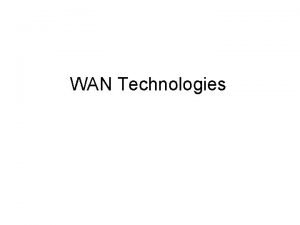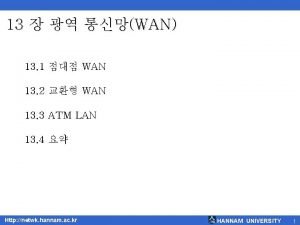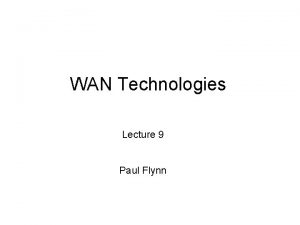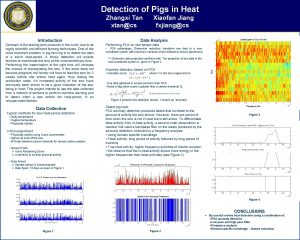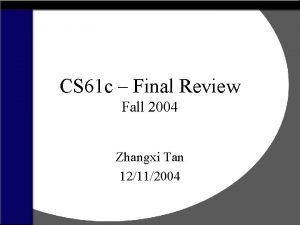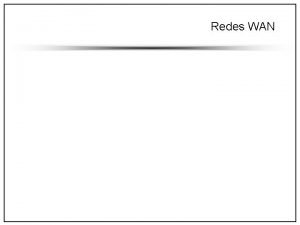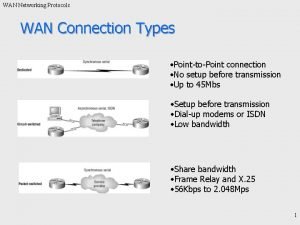Advances of WAN Technologies Zhangxi Lin ISQS 6341
















- Slides: 16

Advances of WAN Technologies Zhangxi Lin ISQS 6341

About SONET Not dead yet Some companies carry IP, ATM, frame relay and Gigabit Ethernet on a SONET transport structure Main beef against SONET: End users can't scale up gradually to get--and pay for--just what they need. Another annoyance is that it traditionally took weeks and a couple of truck rolls to add to any customer's capacity. There is a way to provision bandwidth over SONET in seconds, and at increments of just 1. 5 Mbps. The mistake most competitive carriers made is strictly focusing on customer touch--having facilities in the ground--rather than on the profit per megabit. Value-added voice--that's high revenue. Video is high revenue - May 29, 2001

IP Over SONET A SONET ring provides point-to-point connections between routers. IP packets must, therefore, map to a pointto-point link, for which the most popular solution is using the Point-to-Point Protocol (PPP), defined by the IETF in RFC 1661. – (the technology in 1997)

IP Over SONET

IP over DWDM is the concept of transmitting raw IP packets over an optical layer, using DWDM for its capacity and other operations. This new technical solution can increase the capacity of existing networks without the need for expensive re -cabling and can tremendously reduce the cost of network upgrades. This creates a vision of an alloptical network where all management is carried out in the photonic layer. Transmitting IP directly over DWDM holds the key to the bandwidth glut and opens the frontier of terabit Internets. – http: //www. ari. vt. edu/ece 5516/Optical. Networks/ipdwdm. htm

DWDM (Dense wavelength division multiplexing) A technology that puts data from different sources together on an optical fiber, with each signal carried on its own separate light wavelength. Up to 80 (and theoretically more) separate wavelengths or channel of data can be multiplexing into a lightstream transmitted on a single optical fiber. In a system with each channel carrying 2. 5 Gbps (billion bits per second), up to 200 billion bits can be delivered a second by the optical fiber. Sometimes called wave division multiplexing (WDM). Since each channel is demultiplexed at the end of the transmission back into the original source, different data formats being transmitted at different data rates can be transmitted together. Specifically, Internet (IP) data, Synchronous Optical Network data, and asynchronous transfer mode data can all be traveling at the same time within the optical fiber. Promises to solve the "fiber exhaust" problem and is expected to be the central technology in the all-optical networks of the future. Replaces time-division multiplexing (Time-Division Multiplexing) as the most effective optical transmission method. Although TDM is the primary approach in today's networks, DWDM systems were tested and deployed in late 1998 and 1999.

DWDM – The Solution for the next generation Internet (NGI) If one million families decide they want to see video on Web sites and sample the new emerging video applications, then network transmission rates of terabits (trillions of bits per second [Tbps]) are required. With a transmission rate of one Tbps, it is possible to transmit 20 million simultaneous 2 -way phone calls or transmit the text from 300 years–worth of daily newspapers per second. For some applications the time sensitivity is so important that minimum delay is the overriding factor for all protocol and equipment design decisions. So, there is a need for Burst mode optical data switching. Many transmission protocols require that data packets traverse the network only after a circuit has been established. For some applications, such as periodic transmission of sensor data, this may be an unnecessary overhead to impose.

Multi-layer Stack

Disadvantages of Multi-layer Stack The multi-layer stack has more problems than advantages: • • Every layer now runs at its own speed. So, low speed devices cannot fill the wavelength bandwidth. Increasing Bandwidth, due to this technological revolution, Core technologies are pushed to the edges. Functional overlap: So many layers are doing the same thing, e. g. routing. A failure affects many layers

IP and DWDM - A Winning Combination The good news about optical networking is that it lets carriers deliver huge amounts of bandwidth. The bad news is that it's hard to get money out of those fat pipes. But now, with ATM and SONET/SDH out of the way revenue generating services (which were struggling till now) like IP virtual private networks (VPN) and voice over IP (VOIP) will gain direct access to DWDM resources, and will finally become practical.

Advantages of IP over DWDM Less latency Automatic provision Unified bandwidth service Improved Qo. S

Challenges Any pair of photonic transmission paths cannot use the sane wavelength on a shared fiber link. An algorithm needs to be devised which could route more than 1 line on the same wavelength. There is limited address space arising from physical addressing i. e. there is a finite number of accessible wavelengths.

Multi-Protocol Lambda Switching (MPLambda. S) Lambda switching is derived from Multi-Protocol Label Switching (MPLS). We can assume MPLambda. S to be just implementing Label Switching in the Optical domain. A DWDM network (implementing Lambda switching) is analogical to an ATM network in the aspects of switching. ATM networks perform packet switching based on the virtual circuit number, while the optical channel layer performs switching based on the wavelength of the signal (or packet). Hence the name "Lambda Switching" is applied to the optical network.

The Way to All-Optical Network DWDM is just the first step on the road to full optical networking and the realization of the optical layer. The concept of an All-optical network implies that the service provider will have optical access to traffic at various nodes in the network, much like the SONET layer for SONET traffic. Optical wavelength add/drop (OWAD) offers that capability, where wavelengths are added or dropped to or from a fiber, without requiring a SONET terminal. Combined with OWAD and DWDM, the optical cross-connect (OXC) will offer service providers the ability to create a flexible, highcapacity, efficient optical network with full optical bandwidth management.

Conclusions The future holds many challenges to the All-optical networks. But, the commercial implementations for IP over DWDM are not far away. It provides the backbone to support existing and emerging technologies with almost limitless amounts of bandwidth capacity and opens the pathway to Terabit networking. The trend of IP/DWDM solutions over the last few years seems to have taken an exponential growth. All-optical networking (not just point-to-point transport) enabled by Optical Cross-Connects, Optical programmable add/drop multiplexers, and Optical switches provides a unified infrastructure capable of meeting the telecommunications demands of today and tomorrow. Transparently moving trillions of bits of information efficiently and cost effectively will enable service providers to maximize their embedded infrastructure and position themselves for the capacity demand of the future.

References ATM tutorial at IEC proforum www. iec. org/tutorials/atm_fund/index. html Describes at length ATM technology, ATM classes of services; Highspeed local-area network (LAN) interconnection; ATM standards, ATM multimedia applications in voice, video etc. Sonet tutorial at IEC proforum www. iec. org/tutorials/sonet This Primer provides an introduction to the SONET standard, based on the latest information available from the Bellcore and International Telecommunications Union–Telecommunications Standardization Sector (ITU–T) standards organizations. DWDM tutorial at IEC proforum www. iec. org/tutorials/dwdm This tutorial addresses the importance of scalable DWDM systems in enabling service providers to accommodate consumer demand for ever -increasing amounts of bandwidth. Talk by Dr. Raj Jain on IP over DWDM www. netlab. ohiostate. edu/talks/h_aipwd. htm This streaming video lecture discusses a gamut of issues starting from the need for IP over DWDM to the requirements for creating an all optical networks based on Multi- protocol lambda switching(MPLS).
 Private wan infrastructure
Private wan infrastructure Wan concepts
Wan concepts Atm wan technology
Atm wan technology Wan technologies ccna
Wan technologies ccna Public wan technologies
Public wan technologies Wan connection technologies
Wan connection technologies Dr john wan
Dr john wan Wan technologies
Wan technologies Advances in technology during wwii
Advances in technology during wwii Asset classification norms
Asset classification norms Short term loans and advances
Short term loans and advances Chapter 9 intellectual development of infants
Chapter 9 intellectual development of infants Lurbinectedin posologie
Lurbinectedin posologie Chapter 17 section 2 the axis advances
Chapter 17 section 2 the axis advances Advances in real time rendering
Advances in real time rendering Opto-electronic advances
Opto-electronic advances Advances in memory technology
Advances in memory technology
